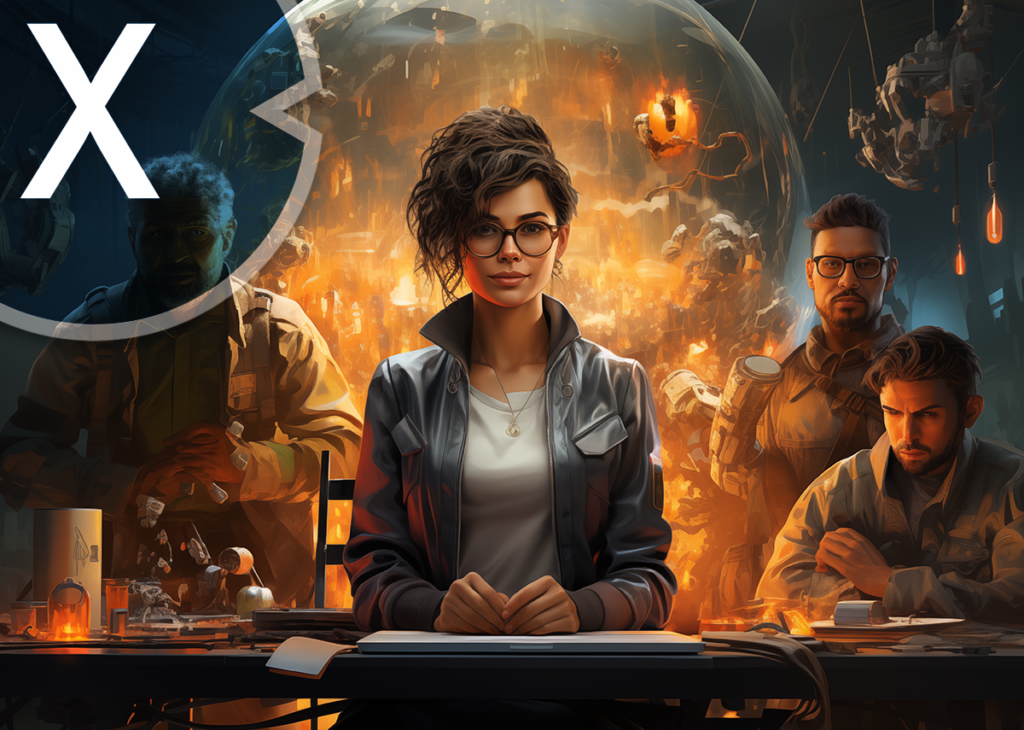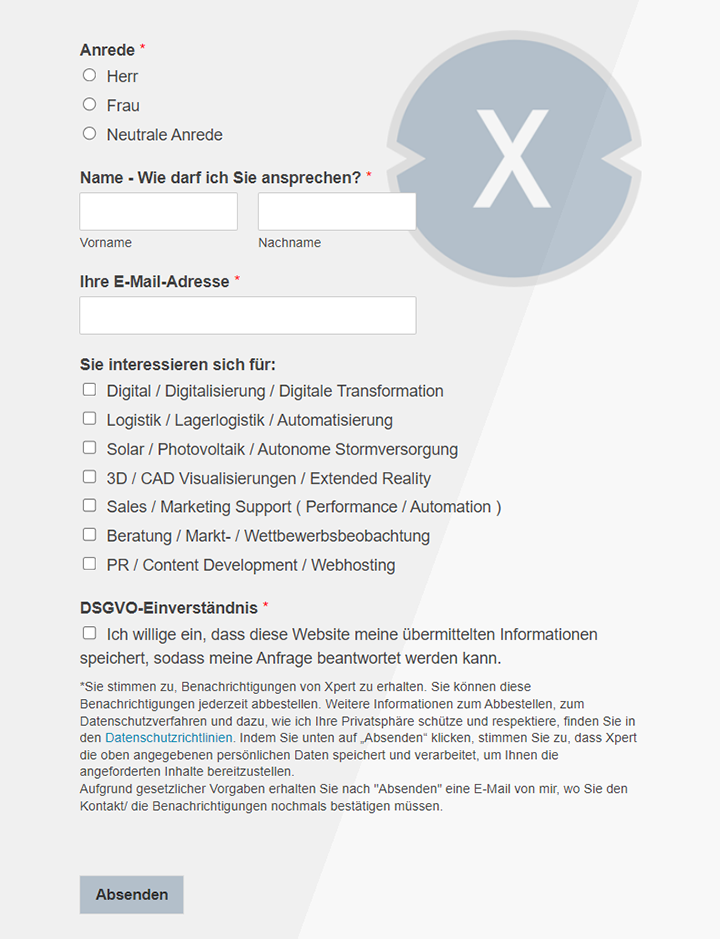500 billion dollars for KI: Will “Stargate” save America's economy or only sell dreams?
Xpert pre-release
Language selection 📢
Published on: January 26, 2025 / Update from: January 26, 2025 - Author: Konrad Wolfenstein

500 billion dollars for KI: Will “Stargate” save America's economy or only sell dreams? - Image: Xpert.digital
Back to the future: Parallels between SDI and the Stargate project of the United States
SDI was a flop - the same fate threatens stargate due to excessive expectations and false promises?
The parallels between the Strategic Defense Initiative (SDI) of the 1980s and the current Stargate project are unmistakable and raise the question of whether the United States could once again fall victim to a major technological project that fails due to excessive expectations and unrealistic promises. Both projects share similar features: high ambitions, geopolitical dimensions and considerable risks that are often underestimated.
High expectations and ambitious goals
Like SDI, the Stargate project is advertised with impressive promises and ambitious goals:
- An investment volume of $ 500 billion over four years: This enormous sum is intended to revolutionize AI research and development.
- Creation of 100,000 new jobs: The aim is to create a variety of highly qualified jobs in the technology industry.
- Technological supremacy of the United States: Stargate is to establish the United States as the world's leading nation in the field of artificial intelligence.
These goals inevitably commemorate the ambitious visions of SDI, which was known under the nickname "Star Wars" and was promoted by President Reagan with great enthusiasm. However, like back then, today's project also has the risk of failing to fail.
Risks of overestimation
Experts warn of a significant discrepancy between the expectations and the realistic feasibility of the promised results. Some central challenges:
- Limited economic effects: According to a study by MIT, KI will only contribute about 1 % to the growth of gross domestic product (GDP) in the next ten years.
- Automation limits: Only 5 % of the tasks that could theoretically be replaced by AI must be automated economically profitably within the next decade.
These figures show that the expected returns are by no means guaranteed. Technological progress is progressing, but often slower than forecast, especially when it comes to complex systems that are deeply embedded in existing economic and social structures.
Geopolitical dimensions
Similar to SDI, Stargate is very geopolitically motivated. The United States is in technological competition with China, which has made considerable progress in the areas of AI and quantum computing in recent years. Stargate's goal is clear:
- Secure technological supremacy: The United States should defend its position as an innovation leader and avoid dependence on foreign technologies.
- Escalation of the tensions: However, there is a risk that an aggressive approach in the area of AI leads to a further fragmentation of the global technology ecosystem.
The parallels to the SDI are obvious. Then as now, there was concern that such a project could lead to an armaments spiral. Instead of securing peace, Stargate could help to tighten the tensions between the USA and other countries, especially China.
Lessons from the past
The story shows that ambitious major projects often fail because of their own expectations. Two prominent examples illustrate this:
The 2017 Foxconn deal
Foxconn, a Taiwanese electronics manufacturer, announced major investments in the United States in 2017:
- Announced: the construction of a 10 billion dollar factory in Wisconsin and the creation of 13,000 jobs.
- Reality: Less than 300 jobs were created by 2020, and the plans for the factory were drastically reduced.
- Consequence: Wisconsin was able to regain $ 2.77 billion of subsidies, but the project was generally considered a failure.
The SDI project of the 1980s
The strategic defense initiative should protect the United States from nuclear threats, but proved to be technically and financially unsustainable:
- Technological challenges: The planned space -based laser weapons and kinetic interceptors were far less effective than expected.
- Cost: Despite investments of $ 29 billion until 1988, the goals could not be achieved.
- Political factors: At the end of the Cold War, the project lost its strategic relevance, and new administrations set other priorities.
The teachings from SDI and other projects such as Foxconn are clear: high expectations and ambitious promises must be associated with realistic planning and a clear strategy in order to avoid disappointments.
The technological and financial challenges of SDI
The technological ambitions of SDI were unprecedented, but they far exceeded the possibilities available at that time. Some of the biggest hurdles were:
- Complexity of the technologies: The development of space -based defense systems proved to be much more complicated and more expensive than planned.
- Legal obstacles: The 1972 ABM contract banned many of the planned systems, which made implementation significantly more difficult.
- Lossness of tests: Systems such as "Brilliant Pebbles" failed in several tests between 1990 and 1992.
Overall, SDI not only failed due to technological and financial problems, but also because of an overestimation of one's own skills and a lack of coordination with international partners.
Can Stargate avoid these errors?
The Stargate project faces similar challenges as SDI, but there are also differences that could give hope:
- Progress in AI: Developments in the field of artificial intelligence are progressing rapidly, and many technologies are more tangible today than the visions of SDI in the 1980s.
- International cooperation: While SDI was strongly unilateral, Stargate could benefit from stronger cooperation with other nations.
- Flexibility: Stargate has the potential to adapt to new developments and react to feedback, which SDI often failed.
Nevertheless, there is a risk that too high expectations and political dynamics overshadow the project. It will be crucial how realistic the goals set and how efficiently the resources are used.
Careful optimism
The Stargate project has the potential to revolutionize the technological landscape of the United States. But the risks - excessive expectations, geopolitical tensions and financial challenges - are significant. The teachings from SDI and other failed major projects can help to ensure more balanced and sustainable implementation. Careful optimism is appropriate, coupled with a realistic assessment of the possible success and risks.
The future will show whether Stargate can keep the promises or whether, like SDI, the history books will end up as a memorial for over -ambitious projects.
🎯🎯🎯 Benefit from Xpert.Digital's extensive, fivefold expertise in a comprehensive service package | R&D, XR, PR & SEM

AI & XR 3D Rendering Machine: Fivefold expertise from Xpert.Digital in a comprehensive service package, R&D XR, PR & SEM - Image: Xpert.Digital
Xpert.Digital has in-depth knowledge of various industries. This allows us to develop tailor-made strategies that are tailored precisely to the requirements and challenges of your specific market segment. By continually analyzing market trends and following industry developments, we can act with foresight and offer innovative solutions. Through the combination of experience and knowledge, we generate added value and give our customers a decisive competitive advantage.
More about it here:
Stargate and SDI: The narrow line between vision and illusion - background analysis
Risk progress: Why the Stargate project is remembered by SDI
The story is often repeated in a surprising way, and so it does not seem absurd to draw parallels between the highly truncing strategic defense initiative (SDI) of the 1980s and the current “Stargate” project. Both projects are characterized by ambitious goals, huge investments and the hope of a fundamental change. But this similarity also carries dangers, because as the past has shown, too high expectations and unrealistic promises can lead to disappointment and even failure.
Stargate: A mega project and the inspiration of past ambitions
“Stargate”, according to the name of the current mega project, is announced with an investment volume of $ 500 billion over a period of four years. It should not only create 100,000 new jobs, but also establish the United States as a leading nation in the field of artificial intelligence (AI). These goals are impressive, and yet they are disturbing in a disturbing way of the exaggerated expectations that were once associated with SDI, also known as “Star Wars”. At that time, a space -based rocket defense system should protect the United States from a nuclear attack.
Lessons from the past: technological hurdles and expectations
The past teaches us that technological jumps are possible, but often do not take place as quickly and smoothly as you hope for. SDI was a prime example of how ambitious plans can fail because of reality. The technological challenges proved to be immense, and many of the advertised breakthroughs remained pure theory. The lasers and kinetic interceptors, which were targeted at the time, were significantly more complex and less effective than originally assumed. The promise of making nuclear weapons “impotent and obsolete” through a rocket defense system proved to be unrealistic, and the immense investments of around $ 29 billion did not lead to the desired results. The excessive expectations collided with the technical possibilities, which led to frustration and finally reducing the funds.
Economic effects of Stargate: a realistic look
There are also voices in “Stargate” that warn of an overestimation of the economic effects. A study by the MIT only forecast a GDP growth of 1 % by AI in the next 10 years. It is also argued that only about 5 % of the tasks that can be theoretically replaced by AI can be automated profitably during this period. These figures indicate that the economic returns hoped for by “Stargate” are by no means guaranteed. The euphoria that the political decision -makers fueled could quickly turn into disillusionment if the actual successes behind the high -tackled goals remain.
Stargate and the geopolitical dimension: old patterns in a new context
Another aspect that has parallels to SDI is the geopolitical dimension of “Stargate”. As with the initiative for rocket defense, the assertion of technological supremacy, this time towards China. The race for AI dominance could lead to an escalation of the tensions and a fragmented global AI ecosystem. Instead of a joint development and use of AI, a scenario could be created in which each country drives its own systems and complicates cooperation. This could lead to a new form of the Cold War, this time not with nuclear weapons, but with algorithms and data.
Lessons from failed major projects: the Foxconn deal
The story shows us again and again that large projects that are started with large -scale announcements often do not keep what they promise. A particularly clear example is the Foxconn deal from 2017. With great pomp, the then US President Trump announced that the Taiwanese electronics manufacturer Foxconn would build a 10 billion dollar factory in Wisconsin and create 13,000 jobs. The project was celebrated as a great success for the American economy. But reality looked different. The promised factory was never realized in the planned form, and instead of 13,000 jobs, only 1,454 were created by 2021. The subsidies of the state of Wisconsin in the amount of $ 3 billion shrank to $ 2.77 billion after it became clear that the ambitious goals were not achieved. This case clearly shows that full -bodied promises and political self -promotion alone do not guarantee economic success.
Reasons for the failure of large projects
The causes of the failure of such projects are diverse. On the one hand, technological challenges can occur unforeseen and delay the implementation or make it impossible. On the other hand, political and economic factors also play a role. Geopolitical conflicts, trade barriers, financial difficulties or a lack of qualified workers can significantly reduce the chances of success of a project. In addition, there is the role of the media and public opinion. If an exaggerated expectation is created at the beginning, the disappointment is all the greater if the actual results do not match the announcements.
Realistic optimism for stargate: a reminder from history
“Stargate” has the potential to advance the USA infrastructure of the USA, and it is important to invest in research and development. But it is also important not to be guided by excessive expectations and false promises. The teachings from SDI and other major projects should serve as a reminder to address the implementation of “Stargate” carefully. It requires a cautious optimism based on realistic expectations. The actual effects and challenges of the project must be discussed honestly and transparently to ensure that investments in AI lead to sustainable and tangible results. It is important to take a long -term perspective and not just strive for short -term success.
Technological development and global competition
In addition to the points already mentioned, which justify a critical view of “Stargate”, further aspects must be taken into account. At the moment, intensive research is being researched and developed worldwide. The assumption that the USA could achieve unchallenged dominance in this area due to “Stargate”. Many countries, including China, invest massively in AI and make rapid progress. A race for technological supremacy is not a sprint, but a marathon that requires endurance, flexibility and a long -term strategy.
Ethical and social issues
Another important point is the question of ethics and the social effects of the AI. The development of AI systems raises numerous ethical questions, for example with regard to data protection, discrimination and the automation of jobs. It is important to discuss these questions openly and transparently and to ensure that the development of AI is in line with the values and needs of society. The one -sided focus on technological dominance could lead to these important aspects being neglected.
Sustainability and economic considerations
In addition, the question of the sustainability of “Stargate” is important. An investment volume of $ 500 billion is enormous. It is important to ensure that these means are used efficiently and in a targeted manner and that investments have long -term positive effects. A pure concentration on short -term goals and neglecting the long -term consequences would be an error.
Challenges in major projects
The challenges and pitfalls in large projects such as “Stargate” or once SDI are often in a mix of technical, political and economic factors. Technical difficulties, unforeseen problems or unexpected developments can drive up the costs, delay the schedules and even make the entire project fail. Political instability, changing priorities or the pressure by the media and the public can also affect the success of such a project. After all, economic constraints, such as financing difficulties, or a change in the market, can endanger the success of the project. The story is full of examples of failed major projects that have failed due to one or more of these factors.
The human factor
Another aspect that is often underestimated in such mega projects is the human component. The development and implementation of such complex projects requires a variety of highly qualified specialists whose skills and cooperation are a crucial success factor. It is not enough to only invest in technology, but also in the people who develop and apply this technology. A lack of qualified workers or internal conflicts can significantly affect the efficiency of a project.
Lessons from the past
The teachings from the past are clear: excessive expectations, false promises and a lack of consideration of reality are the greatest obstacles to the success of major projects. A cautious optimism based on realistic assumptions and open and transparent communication are essential to achieve the desired results. “Stargate” should therefore not be regarded as a race for technological supremacy, but as a way to promote the development of AI responsibly and sustainably. A broad public discussion about the opportunities and risks of AI is essential to ensure that this technology is used for the benefit of humanity.
“Stargate” has the potential to change the USA landscape of the United States, but the risk also carries on too high expectations and rash promises. Experience with SDI and other failed projects should serve us as a warning and stop to pursue a cautious and realistic approach. It is important to take into account the technological, economic, political, social and ethical aspects equally to ensure that “Stargate” does not become another example of a failed dream. An open debate, transparent communication and a long -term strategy are required to use the possibilities of AI responsibly and to minimize the risks.
We are there for you - advice - planning - implementation - project management
☑️ SME support in strategy, consulting, planning and implementation
☑️ Creation or realignment of the digital strategy and digitalization
☑️ Expansion and optimization of international sales processes
☑️ Global & Digital B2B trading platforms
☑️ Pioneer Business Development
I would be happy to serve as your personal advisor.
You can contact me by filling out the contact form below or simply call me on +49 89 89 674 804 (Munich) .
I'm looking forward to our joint project.
Xpert.Digital - Konrad Wolfenstein
Xpert.Digital is a hub for industry with a focus on digitalization, mechanical engineering, logistics/intralogistics and photovoltaics.
With our 360° business development solution, we support well-known companies from new business to after sales.
Market intelligence, smarketing, marketing automation, content development, PR, mail campaigns, personalized social media and lead nurturing are part of our digital tools.
You can find out more at: www.xpert.digital - www.xpert.solar - www.xpert.plus

























